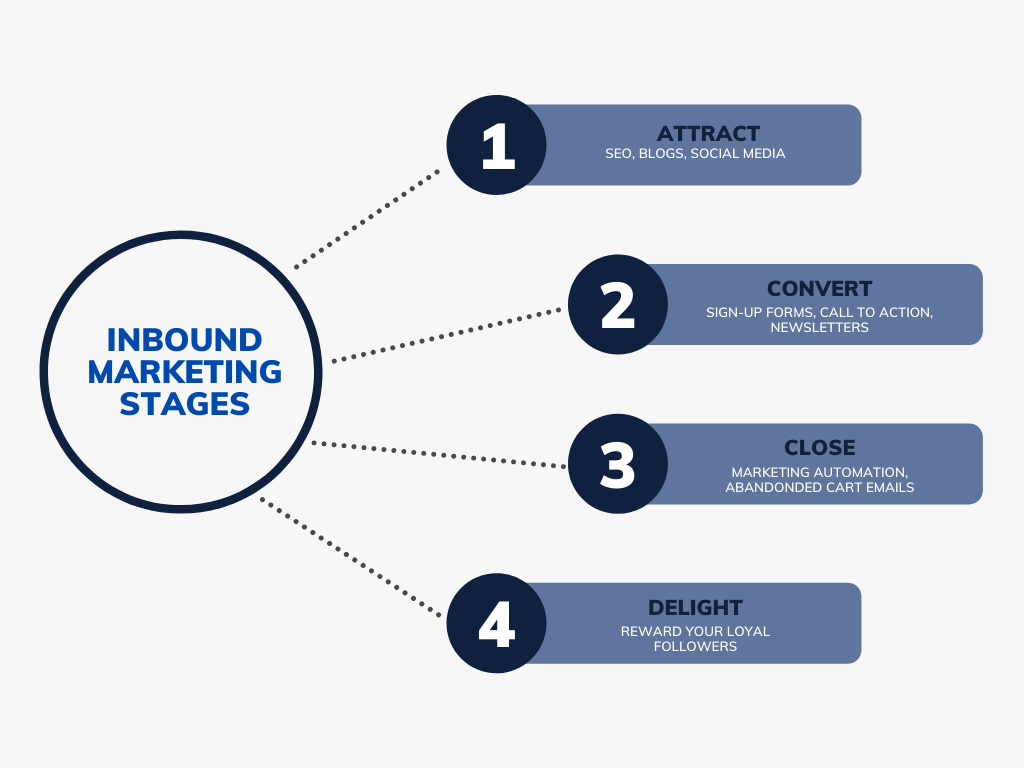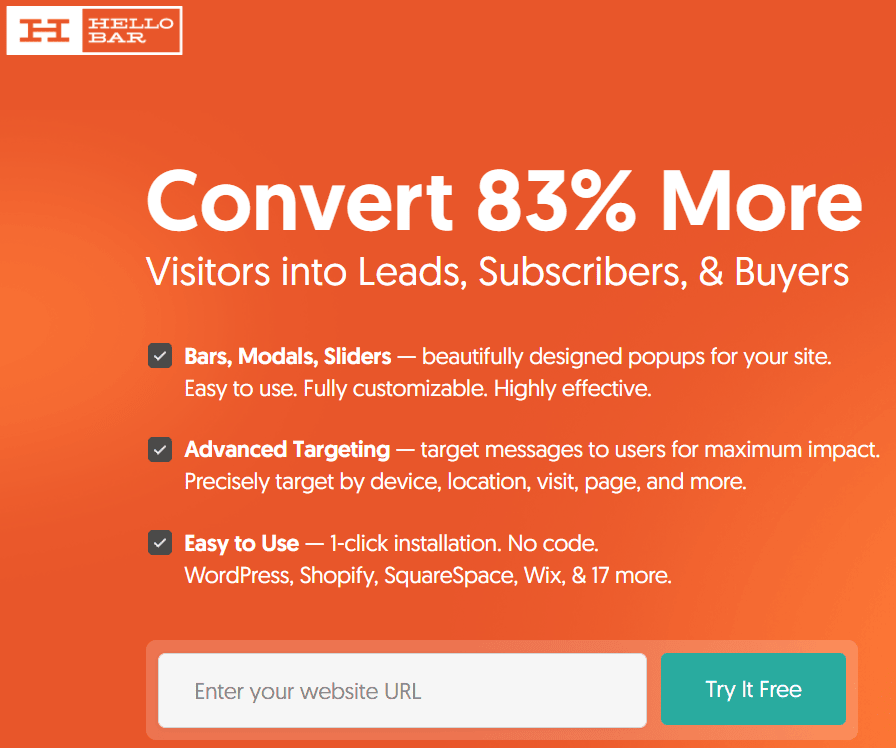Inbound Marketing Strategy in 2024 (19+ Strategies to Rock It!)
Want to create a kick-ass inbound marketing strategy to attract more customers?
Um, duh. 🙄
This turbo-charged business methodology draws consumers to your brand, product, or service.
Why is it so powerful?
Inbound marketing helps you recognize the pain points of your target audience.
Which draws them into the sales funnel.
The result of an effective inbound marketing campaign?
You’ll have established long-lasting relationships with customers, prospects, and clients.
Let’s look behind the scenes and explore how you can fearlessly master inbound marketing.
What Is Inbound Marketing?
Inbound marketing is a powerful customer-centric strategy.
It employs different marketing tactics to draw organic interest in your product, service, or brand.
So, how do you do this?
Marketers need to offer valuable content that solves the issues your audience is looking for a solution to.
Through a multitude of digital marketing tactics.
Some of which include:
- Search engine optimization (SEO),
- Video tutorials,
- Blogs,
- E-books,
- Podcasts,
- Social media posts, and more.
Let’s look at an inbound marketing strategy example.
Say you sell and install home air conditioning.
You want to attract customers looking for a new AC unit for their home. So, you would consider what questions they’re seeking answers to, and focus on creating compelling content that speaks to them.

Creating content that attempts to solve their problems will help entice new customers looking for advice.
And you’ll establish yourself as a subject matter expert.
In a nutshell, an effective inbound strategy provides value first and converts customers later.
Inbound Marketing vs. Outbound Marketing
Inbound marketing and outbound marketing strategies differ in how they approach customers.
The results also differ.
Inbound marketing turns the tables on traditional outbound marketing methods.
It organically “pulls” customers to your company with content that resonates with them.
What’s more, an inbound marketing tactic can be low-cost or even free.
In contrast, an outbound marketing strategy tends to bombard audiences with in-your-face advertising.
You may be thinking of pushy sales techniques such as cold calling or door-to-door sales.
These days, outbound marketing methods like billboards and TV ads are standard.
But, this type of old-school traditional marketing fails to generate desirable outcomes in today’s digital landscape.
Below are the significant differences between inbound marketing vs. outbound marketing.

Benefits of Inbound Marketing
The inbound marketing methodology focuses on finding the right consumers and guiding them towards conversion.
Then, you must continue to delight them even after you’ve made a sale.
You want to empower your customers to achieve their objectives at any stage during their relationship with you.
Brian Halligan, the co-founder of Hubspot, explains why inbound marketing works.
The magic of inbound marketing also:
1. Increases brand awareness
Implementing an inbound marketing strategy for B2B works because of the “pull power.”
You no longer need to go searching for new customers.
Instead of advertising directly to them, you’re focusing on developing reasons why they should come to you.
Did you know that 93% of buying cycles start with an online search?
So, it's crucial to get your brand to appear at the top of the search engine results page (SERP).
Or in users’ social network feeds.
And you’ll organically enhance your brand awareness.
What’s more, being the first brand to pop into potential customers’ minds is enough to triumph over the competition.
Even if they’re not yet ready to buy, simply being present, means being remembered.
2. Fosters brand trust
Don’t underestimate the impact of being a familiar face.
Spend time educating, entertaining, and interacting with potential customers before they consider purchasing.
As a result, you’ll build brand trust and present yourself as an authority in your industry.
Which means consumers will be more likely to buy from you.
3. Generates leads
How do you generate more leads?
Get to know your consumers.
Learn how you can solve their problems.
Then produce helpful, kick-butt content and ensure they know where to find it.
Yes, it can be that simple.
So, now we’ve uncovered why inbound marketing is the bee’s knees.
How do you develop a successful inbound marketing strategy?
Stages of Inbound Marketing

Understand the stages of the inbound marketing funnel to improve your web copy and attract your target customers faster.
What are the 4 types of marketing strategies?
Let’s take a look:
1. Attract
Your goal is to lure consumers who are yet to become customers — called leads — to your site.
You do this through SEO, educational blog posts, social media marketing, and more.
We're sure it comes as no surprise that Google is usually the first step in the consumer buying process.
And you're looking to get more eyeballs on your content, right?
Implementing a solid SEO strategy will help you rank high on Google's SERPs.
Which will position your inbound marketing content to reach your target audience and increase site visitors.
So, adapt it to appeal to more potential customers by solving their problems.
2. Convert
In the convert stage, you want to focus on converting a lead into a prospect.
Blogging is one of the most successful inbound marketing strategies. In fact, 71% of B2B shoppers consume blog content during their customer journey.
So, how can you use an inbound marketing campaign to convert these leads?
- Add a sign-up form to your site
- Include a call to action (CTA) on your blog
- Incentivize newsletter sign-ups
3. Close
Now it’s time to close the sale.
Unfortunately, conversion isn’t always as straightforward as simply offering a sign-up form.
And fingers crossed, they join your community.
One way consumers can enter the closing stage is through marketing automation.
For example, an automated email that reminds users of their abandoned cart may prompt them to return to complete their purchase.
In fact, 45% of abandoned cart emails are opened.
And 50% of the recipients who engaged with the content of abandoned cart emails finalized their purchase.
4. Delight
Woohoo!
You’ve made the sale, so you’re done, right?
Well, not exactly.
The final stage of inbound marketing is rewarding your existing customers for buying from you.
Herein lies the power to convert them into loyal followers.
Kicking off a fierce email marketing campaign is the perfect way to generate repeat business.
The reward could be in the form of a thank you message, personalized follow-up email, future discounts, and more.
Inbound Marketing Strategies
Before you do anything else! You’ll need some excellent inbound marketing tools to automate your content and track customer activity.
So, what is an inbound marketing strategy? Amplify your inbound marketing effort with a mix of the following techniques:
1. Conduct a content audit
Start with a deep dive into your previous content marketing campaigns to evaluate their results and effectiveness.
An initial data gathering strategy will give you a clear overview of what positively and negatively impacted your ROI.
You can also determine what you can re-use and what strategies you should kick to the curb.
Then, you can implement new strategies to supercharge your SEO performance and overall customer experience.
2. Distribute a customer survey
What’s the easiest way to get to know your target audience?
By asking them questions, of course.
If you already have an email list, you can send your subscribers a simple form through SurveyMonkey.
So, what questions do you ask?
You only need to ask one.
“What is your biggest struggle?”
The answers will help you understand their frustrations and what solutions they have already tried.
You can then create persuasive content that promotes your product or service as the best solution.
3. Create a buyer persona
We've already discussed a pivotal element to a successful B2B inbound marketing strategy.
A thorough understanding of your target audience.
You want to build strong relationships that convert leads into customers, right?
So, you need to determine your buyer persona.
This is a semi-fictional depiction of your ideal customer — the people who would benefit most from your product or service.
Define their demographics, preferences, hobbies, challenges, purchasing habits, goals, and pain points.
Then, when you begin planning content per your buyer persona, you can develop customized content and experiences.
The more you understand your target audience and their difficulties, the higher your chances of success.
4. Focus on website design
To attract visitors to your site, you must have a website that’s attractive and easy to navigate.
Plan your website well. If your website doesn’t help attract, engage, and delight your prospective customers, it’s time for a design overhaul.
Or you risk the severe backlash of a high bounce rate.
5. Design mobile-friendly pages

Not only does your website need to be mobilized, but so do your blogs and videos.
Google processes around 40,000 search queries per second. And 64% of those searches are performed on a mobile device.
If your pages aren’t mobile responsive, you’ll be on struggle street trying to convert the traffic you’ve worked so hard to drive there.
So, to appeal to more searchers, your site needs to be accessible and easy to use on all mobile devices.
6. Produce high-quality, in-depth content
High-quality content is the cornerstone of a successful digital marketing strategy.
Entice your audiences with actionable tips and helpful insights through persona-driven content.
Without it, you’ll find it challenging to gain traction and convert readers into qualified leads.
Consider including the following types of content on your website blog:
- How-to guides
- Case studies
- Book summaries
- Tool reviews
- Episodic content
- “A day in the life” post
- Lists
- Videos
Post helpful blogs and long-form informative content to cultivate trust and long-term relationships.
(Want to add a little pizazz to your marketing strategy? Try gamification! Check out everything you need to know about gamification marketing and gamification design.)
7. It’s all about your headlines
Headlines capture the eyeballs of readers.
Therefore, you need to create magnetic headlines that immediately grab their attention.
One of the best ways to do this is to add relevant keywords.
And get in touch with your negative side.
Headlines incorporating “never,” “worst,” and “not” receive loads of clicks.
Conversely, words like “always” or “best” — not so much.

Of course, that doesn’t mean you need to negate all your headlines.
But, if you have a list of common mistakes your customers make, a negative headline can effectively drive more traffic to your site.
8. Create visual content
Make sure there’s more to your written content than just large blocks of text.
Capture your readers’ attention with stunning infographics, charts, videos, and images — every 75 to 100 words is ideal.
Content creators who include more images in their posts report more impressive outcomes.

The more visually appealing your content, the more likely you’ll turbo-charge your results.
9. Tell a story
Perhaps your content is based on data and analytics.
That doesn’t mean it needs to be academic and yawn-worthy.
Instead, focus on creating content that captivates.
You’ll connect with your audience emotionally when you use storytelling in your sales pages, blogs, and social media posts.
As a bonus, storytelling creates excellent brand recall, as 63% of readers are more likely to remember stories than dull statistics.
10. Pitch and guest post — routinely
Guest posting on similar niche publications is a high-impact way to boost your organic traffic and reach new audiences.
For example, before he became the CEO of SmartBlogger.com, Jon Morrow wrote a guest post for ProBlogger.com in 2011.
It’s titled “How to Quit Your Job, Move to Paradise and Get Paid to Change the World.”
The compelling post attracted a whopping number of readers — over 70,000 in the first 24 hours!
We don’t want to get your hopes up.
You may not draw the same number of visitors to your guest post in the same time frame.
But, a well-crafted, compelling blog post on a high-profile site can generate a bucketload of backlinks. And those backlinks can lead to visitors who may not have previously heard of your brand.
But now, they want to know more.
So, pitch to sites with high numbers of engaged readers and write blogs that will offer the greatest return for your time and effort.
And, don’t forget — to gain traction and get the fastest impact from guest posting, you must write consistently!
11. Search engine optimization

SEO positions your content to appear at the top of SERPs and allows searchers to discover you organically.
However, you must understand the kind of content your readers are searching for before you start writing it.
Maximize your SEO effectiveness and grow organic search traffic by researching:
- Keyword trends
- Keyword volume
- Easy to rank for keywords
- How to create better content than your competitors
Conduct basic keyword research using Ahrefs or UberSuggest or stalk your competitor’s sites.
Pepper relevant and long-tail keywords throughout your content to help your audience find you.
Also, incorporate them into the URL, title, and meta description.
As a result, you’ll boost your search visibility and increase your ranking over time.
12. Embrace social media
Social media marketing remains one of the most successful types of inbound marketing for gaining exposure.
A solid social media presence will help you stay connected to your audience. Plus, it will help drive consistent, targeted traffic to your site and increase public knowledge of your brand.
The more you share on social media channels, the more your content will reach potential customers.
Social media is a way for your company to show its human side.
Create awesome content with flair, and you’ll build an online community your customers will want to return to again and again.
13. Collaborate with influencers
A B2B influencer campaign can be beneficial for attracting visitors. In fact, an astounding 90% of brands found influencer marketing effective in their inbound marketing efforts.

Influencers have already built trust and rapport with their audience. Leverage the power of influencer marketing, and their followers will come to trust your brand.
First, work out which influencers are the movers and shakers with high reputations and a large following in your niche.
Collaborate with these influencers to gain exposure and get people amped up about your brand.
14. Create landing pages
Who doesn’t love free stuff?
If customers feel they are receiving something of value without paying anything in return, they’re more likely to buy.
Landing pages are excellent for giving away somethin’ for nothin’ and converting leads in the process.
Offer a free e-book or instructional guide to help your audience learn about a specific topic or product while providing value at the same time.
If a customer is on the fence about a product or service, a freebie can nudge them into making a decision much faster.
Build landing pages with an appealing layout to collect lead information, get newsletter sign-ups, or sell your digital product.
(Pro tip: with the crazy amount of people shopping on their mobile devices, you should seriously consider creating a mobile landing page.)
15. Utilize call to action buttons

Today’s savvy marketers understand one fundamental rule of marketing.
Give before you ask.
Nowadays, customers don’t trust everything they see online.
And rightly so.
We’ve all had it with pop-ups and “in-your-face” advertising.
So, create CTAs that offer value to the customer in exchange for their email or phone number.
A CTA could be a large, bold button on your website or blog.
But, it needs to state what the reader will receive in return. Be specific and avoid a broad request, such as “Contact Us.”
For example, valuable content to offer may include:
- White papers
- E-books
- Tutorials
- A free trial
16. Use a Hello Bar
Drive more conversions with a Hello Bar — a simple tool that allows you to add a signup form at the top of your website.

Since it’s unobtrusive, it won’t distract from the user experience.
It’s a great way to get new leads, subscribers, and buyers.
17. Launch email marketing campaigns
Email marketing is hardly a new concept in outbound marketing and has a massive ROI — with $42 for every $1 spent.
Create a carefully crafted email marketing campaign for prospects who opted-in to receive your company’s emails.
But don’t overdo it.
You don’t want your brand’s reputation associated with annoying, spammy emails. Also, readers could unsubscribe quick-smart if you’re clogging up their inbox.
And, don’t scare subscribers away by immediately pitching your product once they join your email list.
Instead, send them a welcome sequence that gradually introduces them to your offerings and your awesomeness.
It’s a great way to remain in constant touch with your potential customers. Plus, it’s a free form of advertising.
18. Try remarketing
At first glance, remarketing looks like traditional paid advertising.
But you’ve noticed them yourself, haven’t you?
You’ve spent the morning doing a little online shopping.
Then you’ve clicked off and onto Facebook to stalk your friends.
And there they are.
No, not your friends. The items you were just looking at hovering on the side of the page.
Taunting you.
Calling out to you to buy them.
This, friends, is remarketing.
It’s a specific kind of advertising that uses browser cookies to remind you to return to the site and complete your purchase.
Remarketing gives potential customers a second chance to become actual customers. It allows you to sneakily seduce them into returning and finalizing the sale.
19. Nurture leads with personalized, targeted content

Once users have opted into your newsletter, your email marketing campaign will make the sign-up worthwhile.
Nurture leads with personalized content at predetermined, optimal times.
Examples of personalization may be:
- Thank you emails when a lead downloads educational content.
- Sending out relevant content when a lead clicks through to a particular landing page or interacts with a specific CTA.
- Purchase completion.
- Signing up for a newsletter.
Use the proper marketing automation tools, and you could increase qualified leads by 451%.
20. A/B test (and repeat)
A/B testing is an experiment you perform to test two or more variants to determine which one performs better for conversion.
You need to monitor the results of your CTAs, landing pages, and email campaigns to learn what’s working and what’s not.
Make gradual improvements to different components to discover what decreases or increases digital engagement.
If they’re not working as you’d expect, refine your strategies and try something new.
But even if they are working for you, it’s still a great idea to keep going back and making improvements.
Ready to Dive In?
Inbound marketing is 10X more effective than outbound for increasing visitors, leads, and buyers.
Unlike traditional outbound methods, inbound marketing strategies are evergreen. And they provide the most excellent value for your brand.
What's more, you're saving yourself thousands of dollars on outdated marketing strategies.
The moral of the story: put the customer’s needs first, and they will evolve into lifelong customers.
Kirsty Wilson is a Smart Blogger-certified content marketer and self-taught margarita aficionado. With a passion for Digital Marketing and a knack for crafting captivating Landing Page Copy, she sprinkles her Aussie charm and cheeky humour across lifestyle, travel, and marketing blogs. Currently adventuring through Mexico, she documents her solo travels to inspire fellow Gen-X gals to #SeizeTheDay!